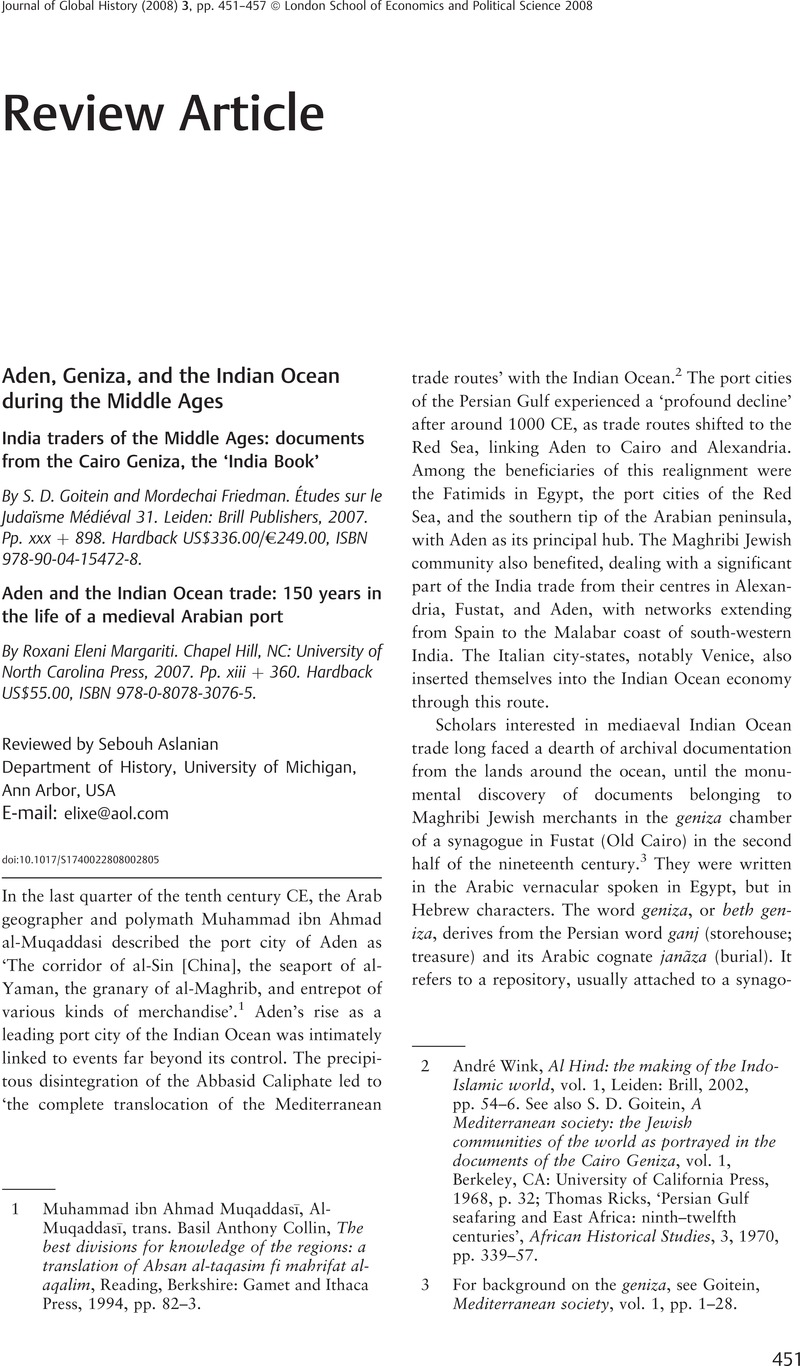No CrossRef data available.
Article contents
Aden, Geniza, and the Indian Ocean during the Middle Ages
Review products
Published online by Cambridge University Press: 01 November 2008
Abstract

- Type
- Review Article
- Information
- Copyright
- Copyright © London School of Economics and Political Science 2008
References
1 Muhammad ibn Ahmad Muqaddasī, Al-Muqaddasī, trans. Basil Anthony Collin, The best divisions for knowledge of the regions: a translation of Ahsan al-taqasim fi mahrifat al-aqalim, Reading, Berkshire: Gamet and Ithaca Press, 1994, pp. 82–3.
2 André Wink, Al Hind: the making of the Indo-Islamic world, vol. 1, Leiden: Brill, 2002, pp. 54–6. See also S. D. Goitein, A Mediterranean society: the Jewish communities of the world as portrayed in the documents of the Cairo Geniza, vol. 1, Berkeley, CA: University of California Press, 1968, p. 32; Thomas Ricks, ‘Persian Gulf seafaring and East Africa: ninth–twelfth centuries’, African Historical Studies, 3, 1970, pp. 339–57.
3 For background on the geniza, see Goitein, Mediterranean society, vol. 1, pp. 1–28.
4 Roxani E. Margariti, Aden and the Indian ocean trade: 150 years in the life of a medieval Arabian port, Chapel Hill, NC: University of North Carolina Press, 2007, pp. 13, 18.
5 S. D. Goitein, ‘From the Mediterranean to India: documents on the trade to India, South Arabia, and East Africa from the eleventh to twelfth centuries’, Speculum, 29, 1954, p. 183; and Goitein, Mediterranean society, vol. 1, p. 26.
6 See, for example, the following from Abraham L. Udovitch: Partnership and profit in medieval Islam, Princeton, NJ: Princeton University Press, 1970; ‘Theory and practice in Islamic law: some evidence from the Geniza’, Studia Islamica, 32, 1970, pp. 289–303; ‘Time, the sea, and society: duration of commercial voyages on the southern shores of the Mediterranean during the high middle ages’, in La navigazione mediterranea nell'alto medioevo, Spoleto: Presso la Sede del Centro, 1978, vol. 2, pp. 503–47. See also R. Chakravarti, ‘Nakhudas and Nauvittakas: ship-owning merchants in the west coast of India (c. A.D. 1000–1500)’, Journal of the Social and Economic History of the Orient, 43, 2000, pp. 34–64.
7 Goitein, ‘From the Mediterranean’; idem, ‘Two eyewitness reports on an expedition of the King of Kish (Qais) against Aden’, Bulletin of the School of Oriental and African Studies, 16, 1954, pp. 247–57.
8 S. D. Goitein, Letters of medieval Jewish traders, Princeton, NJ: Princeton University Press, 1973, pp. 175–229.
9 See Goitein Mediterranean society, I, p. 7.
10 Ibid., vol. 1, p. 149.
11 See Udovitch, ‘Theory and practice’.
12 Robert S. Lopez and Irving W. Raymond,Medieval trade in the Mediterranean world: illustrative documents, New York: Columbia University Press, 1955; 2nd edition, 2001.
13 Li Guo, Commerce, culture and community in a Red Sea port in the thirteenth century: the Arabic documents from Qusair, Leiden: Brill, 2004.
14 Goitein, Mediterranean society, vol. 1, p. 9.
15 See Sanjay Subrahmanyam, ‘Connected histories: notes towards a reconfiguration of early modern Eurasia’, Modern Asian Studies, 31, 3, 1997, pp. 735–62.
16 See Marshall G. S. Hodgson, The venture of Islam: conscience and history in a world civilization, Chicago: University of Chicago Press, 1977, vol. 1, p. 59.
17 See also Mark Cohen, ‘Goitein, Geniza and Muslim history’, 2001, http://www.dayan.org/mel/cohen.pdf (consulted 3 September 2008), and the earlier account by Goitein in Mediterranean society, vol. 1, pp. 70–4.
18 See M. N. Pearson, The Indian ocean, London and New York: Routledge, 2003, pp. 31–2.
19 See especially Frank Broeze, ed., Brides of the sea, gateways of Asia: port cities in Asia in the 13th–20th centuries, Honolulu: University of Hawaii Press; Michael N. Pearson, Port cities and intruders: the Swahili coast, India, and Portugal in the early modern era, Baltimore, MD: Johns Hopkins University Press, 1988; Pearson, Indian ocean.
20 Rhoads Murphey, ‘On the evolution of the port city’, in Broeze, Brides of the sea, p. 225. See also Pearson, Indian ocean, p. 32.
21 Margariti, Aden, pp. 103–4. For funduks, see Olivia Remie Constable, Housing the stranger in the Mediterranean world: lodging, trade, and travel in late antiquity and the middle ages, Cambridge: Cambridge University Press, 2003.
22 Jeremy Edwards and Sheilagh Ogilvie, ‘Contract enforcement, institutions and social capital: the Maghribi traders reappraised’, CESifo Working Paper No. 2254, 2008, http://SSRN.com/abstract=1107801 (consulted 3 September 2008). See also Greif's compelling response, ‘Contract enforcement and institutions among the Maghribi traders: refuting Edwards and Ogilvie’, CESifo Working Paper No. 2350, 2008, http://ssrn.com/abstract=1159681 (consulted 3 September 2008).


